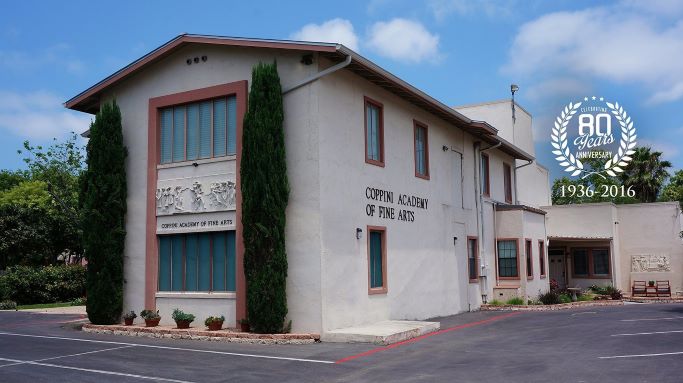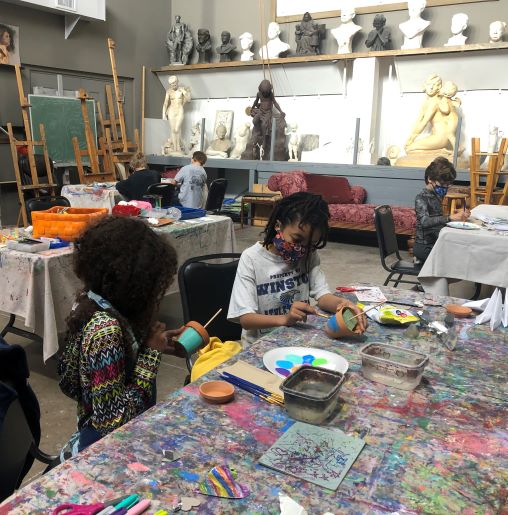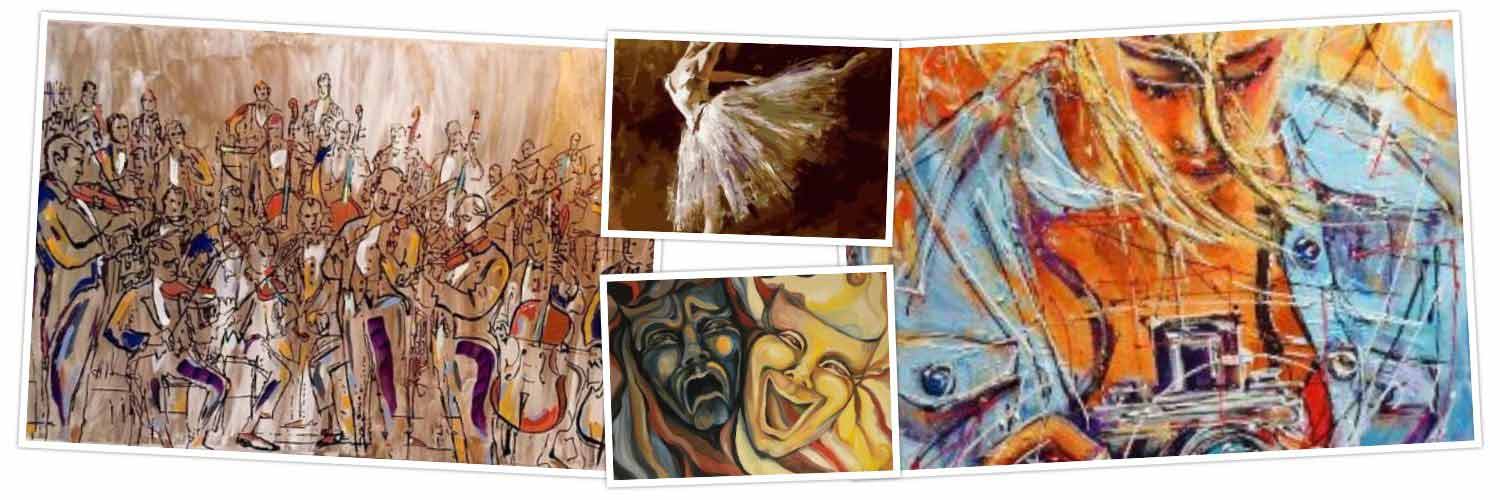Fine Art – “Old School”: After 70 Years, Coppini Academy of Fine Arts is Still in Class
By BERIT MASON
The artist glances at the model, to draw the line of her leg just right. Classical music plays softly in the background while busts of stern philosophers and great artists from the past aloft on shelves, look down. It looks like a scene from the Arts Students League in New York. But this relaxed, quiet atmosphere welcomes artists at San Antonio’s equally respected Coppini Academy of Fine Arts.

Tucked away on a side street opposite the stony mansions of Olmos Park, stands a faded pink two-story villa, adorned with a Grecian frieze and two tall fir trees. You could say it’s on the “wrong side” of the tracks of McCullough.
The venerable art school doesn’t have glass walls or major corporate donor programs. The Coppini Art Academy is funded by a trust. Chartered in 1952, the nonprofit is “dedicated to the promotion of classical, representational fine art,” and is actually located in the “atelier” of the late sculptor Pompeo Luigi Coppini who willed his studio to the community.
Coppini was born in 1870 in Italy. After emigrating to the U.S., he eventually moved to San Antonio to take up his commission to create Alamo Plaza’s “Spirit of Sacrifice,” the Alamo Cenotaph, a monument to the fallen men at the Battle of the Alamo that still proudly stands in Alamo Plaza. The academy was built in 1936 and he worked and resided at the studio, while working on the Cenotaph which he completed in 1940. At that’s just one of his monumental works. Coppini’s creations can be found in Italy, Mexico and other U.S. states, though most of the sculptures are in Texas, including statues of statesmen and fallen heroes.

Today, the Coppini Academy is an art school in the most traditional sense. If Gaugin were alive, this is where you would find him. Writer Stephen Harrigan wrote of Coppini in Texas Monthly in 1984: “In matters of technique, he was appealingly businesslike, but otherwise he breathed the thin air of artistic piety. He believed that only the loftiest principles were worthy of expression.”
Walk into this wonderful old building and an easel and tables await. On Wednesday evenings, artists of differing skill levels participate in a session called “Figurative Long Pose.” On Thursdays, students draw while models execute quick changing poses.
Carl is the facilitator of what they call “an open session,” meaning a session open to all. He makes sure that artists and models have what they need.
“You just kind of decide what you want to do on your own,” he explains. “Students might do a session with watercolor one week and oil the next.”
He suggests that anyone interested in art, should pay a visit.
“Student artists have different skill levels. Some people just enjoy what they are doing and some are very gifted—but this does not matter in an open session because this is not a graded-type thing. You are here to enjoy yourself and let the creative juices flow.”
During the height of the Covid-19 pandemic, the building was shuttered like so many other communal places. When it reopened last year, student-artist Jorge Molina happily returned to his classes, driving from Austin every few weeks. “I have been coming here since 2014,” he said. “I was really impressed because this is the sort of traditional academic art that I prefer. It’s a great venue for prominent artists who don’t live in San Antonio to come here and teach workshops.”
For Molina, it’s worth the trip down I-35. He says that until four years ago, no such fine arts academy existed in Austin—though today they have “Atelier Dogo Austin,” for which the Coppini was an inspiration.
“I come when I can and I am always impressed by the caliber of artists that come here,” says Molina.
*
On the day the school reopened this year after the summer break, we observed eight students completely absorbed in their work. Chris, a former paramedic was one of them. “Art is my hobby and my passion,” he said. “I do a little painting but I love the figure drawing and I love rubbing elbows with all of these other talented people.”
A recent news item examined the benefits of creating art because of how deeply people are absorbed in their work.
“If someone is just beginning, they are going to be discouraged with their own work because everyone is their own worst critic. But once you get past that point, and learn to enjoy what you are doing, enjoy the learning and the process, to see things with your own eyes—yes, it is very relaxing,” said the retiree. As he worked to bring the model to life with his pencil, he added: “It is a studio. Not a rented classroom, rented room, or warehouse where someone cut a corner out of it. When you step into the studio itself, you see and feel that history.” He seemed proud of that.

There’s no abstract art here. Lessons focus on “representational” art.
So, what is representational art?
“Making things look like they are,” explains the president of the board of directors of the Academy, Steven DaLuz, an established and successful artist himself. “It does not mean you cannot paint a landscape that is impressionistic, if it still represents a landscape. If it is just blobs of color, that is not what we are about.”
DaLuz and the board have the great responsibility to continue Coppini’s legacy.
“We are not really a school,” says DaLuz. “We are a nonprofit organization that provides this place for artists to meet and engage in education … we do offer classes … in beginning painting, intermediate painting, oil and acrylic. We just started a drawing class on Monday evenings.”
Unlike “accredited” schools, however, they do not issue college degrees. But enrollees learn the fundamentals. They learn technique and about the various media, and they learn to draw, the basic building blocks of a classical art education.
“We are trying an evening approach,” explains DaLuz. “We are trying to pull in people who may have time in the evening after they come home from work. This particular class will be teaching them about the fundamentals of drawing with a figure from life. You are not going to get a lot of that in the colleges and universities. There is no one instructing you about any principles or how to construct the figure.
“We hope to be a place that provides that alternative because there are young people who are not getting what they need,” he says. “The Academy is run by volunteers, which is why “we can keep the costs as low as they are.”
DaLuz also points out that the institution is trying to attract younger students, and establish children’s programs.
At the moment, they are all looking forward to their new classes and a November exhibit.
“These are serious artists… when you walk around, you’ll see what amazing work they are doing,” says DaLuz.
Brenda Cascio, who holds a degree in fine arts, is serious. “No one looks for a degree to see if you are qualified. Your art speaks for itself,” she asserts.
And DaLuz sums the Academy’s significance: “The Coppini provides a place where artists can meet, where they can paint and draw. We are one of the very few places where an artist can go outside of academia and find what we provide here.”
——————————————————————————————————————–Membership is $50 a year; a 12-week class is $300; for class information and schedule go to https://www.thecoppini.org

I am delighted to read this report and coverage of this ideal venue for artists to learn and interact. I will certainly share as well as become a member plus do what I can to support this marvelous institution. Perhaps organization is a better word. Perhaps both suit it better for those who do not know the depth of the word Atelier which is thecorrect term to describe this amazing space. Let us keep it as an Atelier, independent of state and government funding, read control; for then we would lose it all.
I have recently relocated to Texas, and S.W Texas, and had not known of such a wonderful possibility.
Looking forward to visiting the Atelier.
Wonderful, informative article.
Coppini was a friend of my great grandfather.
Thank you,
MargaretHouston